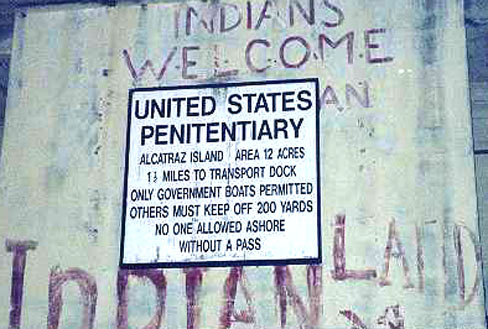Until the federal penitentiary was closed in 1963, Alcatraz Island was a place most folks tried to leave. On November 20, 1969, the island’s image underwent a drastic makeover. That was the day thousands of American Indians began an occupation that would last until June 11, 1971.
The 1973 armed occupation of Wounded Knee along with the siege at the Pine Ridge Reservation one year later (which led directly to the incarceration of Leonard Peltier) are etched deeper in the public consciousness in terms of recent Indian history, but is was the Alcatraz Island occupation that ushered in a new era of Native American activism.
“The occupiers,” writes Ben Winton in the Fall 1999 issue of Native Peoples magazine, “were an unlikely mix of Indian college activists, families with children fresh off reservations and urban dwellers disenchanted with what they called the U.S. government’s economic, social and political neglect.”
“We hold The Rock,” proclaimed Richard Oakes, a Mohawk from New York. Oakes became the occupiers’ spokesman . . . and his words became their motto. “The occupation of Alcatraz was about human rights,” said Winton. “It was an effort to restore the dignity of the more than 554 American Indian nations in the United States.”
Over the course of the occupation, over 5,600 American Indians took part — some for a day, some for the entire 18 months. Twenty-three year-old John Trudell, a Santee Sioux from San Bernardino, California heard about the occupation, packed a sleeping bag, and headed to Frisco. “He became the voice of Radio Free Alcatraz, a pirate station that broadcast from the island with the help of local stations” explains Winton. “When he hit the airwaves, the response was often overwhelming. Boxes of food and money poured in from everywhere-from rock groups such as The Grateful Dead and Creedence Clearwater Revival (who staged a concert on a boat off Alcatraz and then donated the boat), Jane Fonda, Marlon Brando, city politicians, and everyday folks.” For the first time in modern American history, the plight of Native Americans was making headlines.
The fledgling American Indian Movement (AIM) visited the occupiers and soon began a series of their own occupations across America. AIM would soon become a powerful multi-tribal protest organization . . . just one of the many important outcomes of the Alcatraz takeover.
“Despite its chaos and factionalism, the event resulted in major benefits for American Indians,” Winton states. “Years later, Brad Patterson, a top aide to President Richard Nixon, cited at least ten major policy and law shifts.” Some of those policy shifts include:
- Passage of the Indian Self Determination and Education Act
- Revision of the Johnson O’Malley Act to better educate Indians
- Passage of the Indian Financing Act and the Indian Health Act
- Creation of an Assistant Interior Secretary post for Indian Affairs
Even today, Alcatraz Island remains part of Native American culture as every November since 1975, on what is called “Un-Thanksgiving Day,” Indians gather on the island to honor the occupation and those who continue to fight today.
Mickey Z. is the author of several books, most recently 50 American Revolutions You’re Not Supposed to Know: Reclaiming American Patriotism (Disinformation Books). This essay is an excerpt from 50 American Revolutions You’re Not Supposed to Know. For more info, please visit <http://www.mickeyz.net>.



